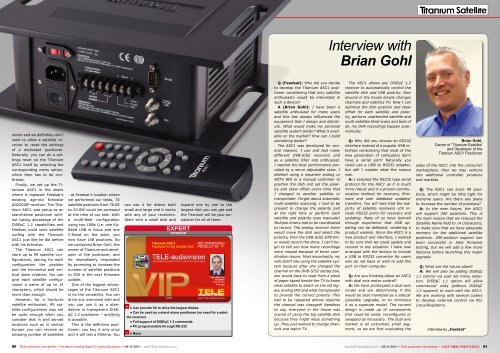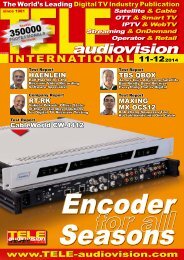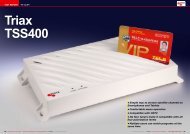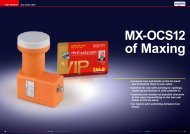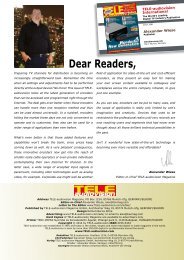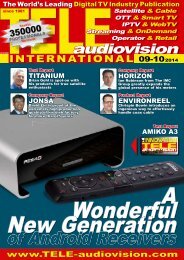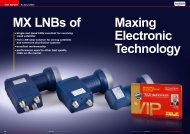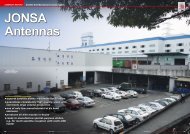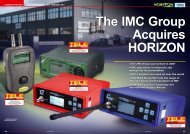Titanium ASC1
Create successful ePaper yourself
Turn your PDF publications into a flip-book with our unique Google optimized e-Paper software.
Interview with<br />
Brian Gohl<br />
motor and we definitely don’t<br />
want to allow a satellite receiver<br />
to reset the settings<br />
of a dedicated positioner.<br />
Naturally, you can do a settings<br />
reset on the <strong>Titanium</strong><br />
<strong>ASC1</strong> itself by selecting the<br />
corresponding menu option,<br />
which then has to be confirmed.<br />
Finally, we set up the <strong>Titanium</strong><br />
<strong>ASC1</strong> in the shack<br />
where it replaced Feedsat’s<br />
existing age-old Echostar<br />
AD2500IP receiver. The <strong>Titanium</strong><br />
<strong>ASC1</strong> was setup as an<br />
stand-alone positioner without<br />
taking advantage of the<br />
DiSEqC 1.2 capabilities and<br />
Feedsat could start satellite<br />
surfing with the <strong>Titanium</strong><br />
<strong>ASC1</strong> just like he did before<br />
with his Echostar.<br />
The <strong>Titanium</strong> <strong>ASC1</strong> can<br />
store up to 99 satellite configurations,<br />
storing for each<br />
configuration the position<br />
and the horizontal and vertical<br />
skew rotation. You can<br />
give each satellite configuration<br />
a name of up to 14<br />
characters, which should be<br />
more than enough.<br />
However, for a hardcore<br />
satellite enthusiast, 99 satellite<br />
configurations may not<br />
be quite enough when you<br />
consider that in well served<br />
locations such as in central<br />
Europe you can receive an<br />
amazing number of satellites<br />
- at Feedsat’s location where<br />
we performed our tests, 74<br />
satellite positions from 76.0E<br />
to 63.0W could be accessed<br />
at the time of our test. With<br />
a multi-feed configuration<br />
using two LNBs (i.e. one Ku-<br />
Band LNB in focus and one<br />
C-Band on the side), you<br />
now have 148 positions. So<br />
we contacted Brian Gohl, the<br />
owner of <strong>Titanium</strong> and developer<br />
of the positioner, and<br />
he immediately responded<br />
by promising to increase the<br />
number of satellite positions<br />
to 200 in the next firmware<br />
update.<br />
One of the biggest advantages<br />
of the <strong>Titanium</strong> <strong>ASC1</strong><br />
is its the versatility. You can<br />
drive any oversized dish and<br />
you can use it as a standalone<br />
or transparent DiSEqC<br />
1.2 positioner – anything<br />
is possible.<br />
This is the definitive positioner;<br />
you buy it only once<br />
and it will last a lifetime. You<br />
can use it for dishes both<br />
small and large and it works<br />
with any of your receivers.<br />
Start with a small dish and<br />
expert<br />
OPINION<br />
+ ● Can provide 5A to drive the largest dishes<br />
● Can be used as a stand-alone positioner (no need for a satellite<br />
receiver)<br />
● Full support of DiSEqC 1.2 commands<br />
● PC programmable through RS-232<br />
–<br />
● None<br />
<strong>Titanium</strong> <strong>ASC1</strong><br />
Positioner for Big Satellite Dish<br />
expand one by one to the<br />
largest dish you can get and<br />
the <strong>Titanium</strong> will be your positioner<br />
for all of them.<br />
RECOMMENDED<br />
PRODUCT BY<br />
Vitor Martins<br />
Augusto<br />
Test Center<br />
Portugal<br />
Q (Feedsat): Why did you decide<br />
to develop the <strong>Titanium</strong> <strong>ASC1</strong> positioner<br />
considering that only satellite<br />
enthusiasts would be interested in<br />
such a device?<br />
A (Brian Gohl): I have been a<br />
satellite enthusiast for many years<br />
and this has always influenced the<br />
equipment that I design and distribute.<br />
What would make my personal<br />
satellite system better? What is available<br />
on the market? How can I build<br />
something better?<br />
The <strong>ASC1</strong> was developed for several<br />
reasons. I use and test many<br />
different DVB-S/S2 receivers and<br />
as a satellite DXer and enthusiast,<br />
I wanted the best performance provided<br />
by a servo adjustable skew. I<br />
disliked using a separate analog or<br />
4DTV IRD or a manual controller to<br />
position the dish and set the polarity<br />
and skew offset every time that<br />
I changed to another satellite or<br />
transponder. Forget about automatic<br />
multi-satellite scanning. I had to be<br />
present to change the polarity just<br />
at the right time or perform each<br />
satellite and polarity scan manually!<br />
Multiple timers had to be coordinated<br />
to record. The analog receiver timer<br />
would move the dish and select the<br />
polarity, then the DVB-S/S2 STB timer<br />
would record the show. I can’t begin<br />
to tell you how many recordings<br />
were missed because of timer coordination<br />
issues. Most importantly, my<br />
wife didn’t like using the satellite system<br />
because after she changed the<br />
channel on the DVB-S/S2 settop box,<br />
she would have to read from a piece<br />
of paper taped beside the TV to know<br />
what satellite to select on the old legacy<br />
analog IRD and what transponder<br />
to provide the correct polarity. This<br />
had to be repeated almost anytime<br />
the channel was changed! Needless<br />
to say, everyone in the house was<br />
scared of using the big satellite dish<br />
because they might mess something<br />
up. They just wanted to change channels<br />
and watch TV.<br />
The <strong>ASC1</strong> allows any DiSEqC 1.2<br />
receiver to automatically control the<br />
satellite dish and LNB polarity. Now<br />
anyone in the house simply changes<br />
channels and watches TV. Now I can<br />
optimize the dish position and skew<br />
offset for each satellite and polarity,<br />
perform unattended satellite and<br />
multi-satellite blind scans and best of<br />
all, my DVR recordings happen automatically.<br />
Q: Why did you choose an RS232<br />
interface instead of a popular USB interface<br />
considering that most of the<br />
new generation of computers don’t<br />
have a serial port? Naturally you<br />
could use a USB to RS232 adapter,<br />
but still I wonder what the reason<br />
was.<br />
A: I selected the RS232 type serial<br />
protocol for the <strong>ASC1</strong> as it is much<br />
more robust and is a proven communication<br />
method for recovery, firmware<br />
and user database updates/<br />
transfers. You will note that the majority<br />
of satellite receivers still include<br />
RS232 ports for recovery and<br />
updating. Many of us have learned<br />
through experience that USB updating<br />
can be defeated, rendering a<br />
product useless. Since the <strong>ASC1</strong> is a<br />
new product and interface, I wanted<br />
to be sure that we could update and<br />
recover in any situation. I have now<br />
arranged with the factory to include<br />
a USB to RS232 converter for users<br />
who do not have or wish to add this<br />
port on their computer.<br />
Q: Are you thinking about an ASC2<br />
with dual axis motor control?<br />
A: We have prototyped a dual axis<br />
model and are determining if this<br />
would be best marketed as a sidecar<br />
(possible upgrade) or to introduce<br />
it as a separate model. The current<br />
design is made up of components<br />
that could be easily reconfigured or<br />
swapped as necessary. The dual axis<br />
market is an extremely small segment,<br />
so we are first evaluating the<br />
Brian Gohl,<br />
Owner of ‘<strong>Titanium</strong> Satellite’<br />
and Developer of the<br />
<strong>Titanium</strong> <strong>ASC1</strong> Positioner<br />
sales of the <strong>ASC1</strong> into the consumer<br />
marketplace, then we may venture<br />
into additional controller products<br />
and markets.<br />
Q: The <strong>ASC1</strong> can store 99 positions,<br />
which might be little tight for<br />
extreme users. Are there any plans<br />
to increase the number of positions?<br />
A: In the near future, the <strong>ASC1</strong><br />
will support 200 positions. This is<br />
the main reason that we reduced the<br />
Satellite Name field to 14 characters,<br />
to make sure that we have adequate<br />
memory for the additional satellite<br />
positions. 200-position support has<br />
been successful in beta firmware<br />
testing, but we will add a few more<br />
features before launching this major<br />
upgrade.<br />
Q: What are the future plans?<br />
A: We will also be adding DiSEqC<br />
1.1 control via user set menu selection.<br />
DiSEqC 1.1 option will allow<br />
commercial units (without DiSEqC<br />
1.2 support) to work with the <strong>ASC1</strong>.<br />
We are working with several coders<br />
to develop external control via PC/<br />
Linux/Raspberry.<br />
Interview by „Feedsat“<br />
80 TELE-audiovision International — The World‘s Leading Digital TV Industry Publication — 09-10/2014 — www.TELE-audiovision.com<br />
www.TELE-audiovision.com — 09-10/2014 — TELE-audiovision International — 全 球 发 行 量 最 大 的 数 字 电 视 杂 志 81


